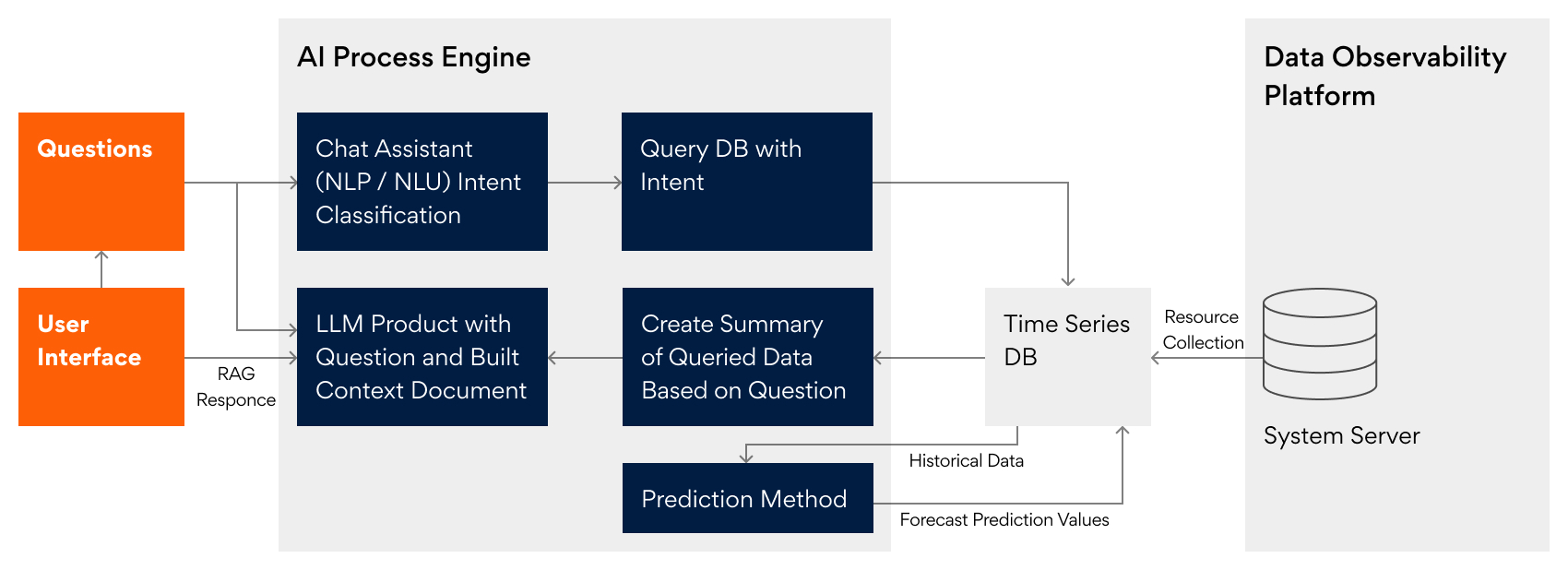Part three of three.
In our previous blogs, we looked at the criticality of data observability and the roles Predictive AI and Generative AI (GenAI) can play. Let’s now consider how a leading AI technology solution can meet the evolving objectives of data efficiency, enhanced insight and observability, for modern organizations.
To begin, here’s the methodology behind computing the CPU forecast value for a designated week (prior to the current date). After extracting the requisite data, and completing the required computations, we employ a systematic approach to convert the data into a format consumable by the large language model (LLM). This format encompasses a single contextual corpus document per inquiry, ensuring 100% fidelity of the generated response.

The diagram above illustrates an AI-driven process engine seamlessly integrated into a data observability platform. This engine orchestrates the predictive methodology responsible for generating forecasts alongside the GenAI RAG model (Retrieval-Augmented Generation).
Initially, the query undergoes classification to determine the underlying intent, which may include diverse metrics and temporal parameters. For example, consider this inquiry:
“For the last week, what was my average CPU utilization for admin jobs?”
The process engine examines pertinent data and metrics from the preceding week – juxtaposing them with current datasets – and it monitors CPU utilization during the execution of administrative tasks. Next, the system determines the query’s intent and the required computation for the intended response. In case the average CPU performance during the specified timeframe needs to be computed, the engine formulates the query to retrieve the right information from the database. If a predictive forecast is mandated, the process engine undertakes the necessary calculations.
Here’s another sample query, with a predictive request:
“What will my CPU usage be for the next month with current workload?”
This would be handled through the same meticulous process.
The AI Advantages in Data Observability
This integration of GenAI and Predictive AI solutions within a data observability platform offers multiple benefits – most notably, the enhancement of proactive alerting capabilities through predictive forecasting. This enables administrators to adjust or restrict system usage preemptively, averting potential events triggered by resource overages that could lead to outages. Consequently, data availability remains a consistent and fundamental goal of data observability.
Further, this integration introduces an additional layer to the visualization of data observability: while many platforms offer graphical representations of data observability metrics, few provide detailed insights or explanations regarding the implications of these visualizations for current or future occurrences. By incorporating AI into these platforms, interpreting visual data becomes less of a guessing game, particularly within complex environments. Instead, it offers a more grounded approach to deriving actionable insights.
The integration of Generative AI and Predictive AI solutions represents a significant evolutionary step for data observability. Today, advanced tools and platforms help ensure data quality, reliability, and consistency throughout its lifecycle. With enterprises increasingly seeking near real-time decision-making capabilities, organizations are turning to AI to manage massive data volumes and support enhanced data observability. There are other advantages, including proactive alerting capabilities facilitated by predictive forecasting, allowing administrators to preemptively adjust system usage to avoid potential outages triggered by resource overages, thus ensuring continuous data availability.
The incorporation of an AI infusion process engine into data observability platforms introduces an additional layer to visualization elements, providing deeper insights into data metrics and their implications for current and future occurrences. By leveraging AI, organizations can move beyond reactive solutions and adopt a proactive approach to data observability, thereby driving operational efficiency and informed decision-making.
Overall, GenAI and Predictive AI offers takes data observability to new levels with enhanced proactive alerting, improved visualization, and deeper insights into data metrics. By embracing AI, organizations can navigate the complexities of modern data ecosystems with greater agility and precision, and ultimately utilize data observability to drive innovation and strategic growth opportunities.






